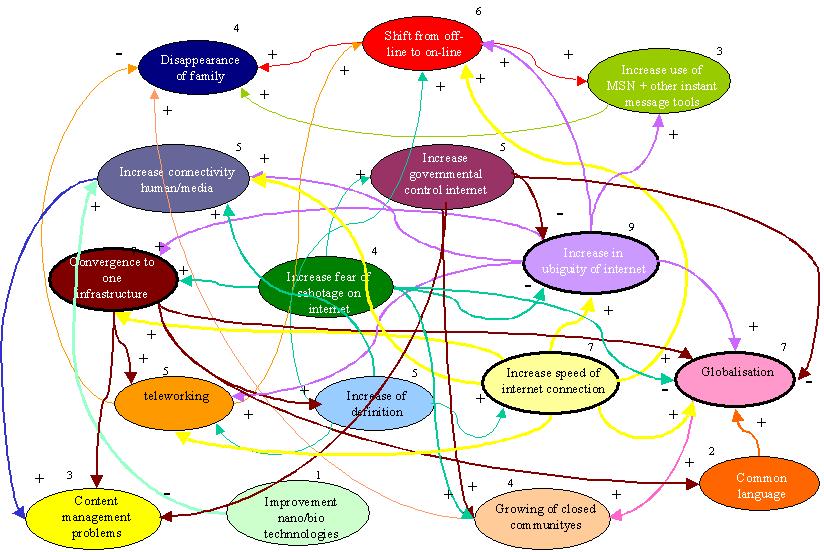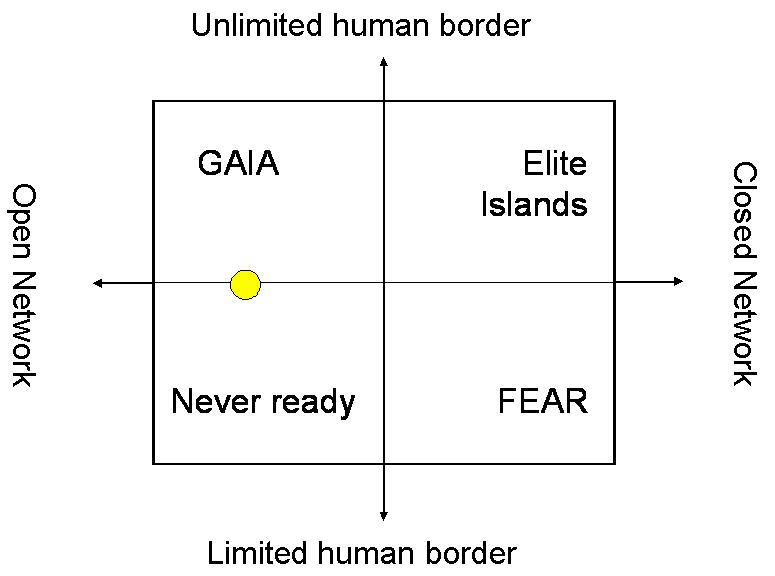Difference between revisions of "The future of communication in 2015"
E.lousberg (talk | contribs) |
E.lousberg (talk | contribs) |
||
| Line 76: | Line 76: | ||
With this vision four scenario's are defined:<br> | With this vision four scenario's are defined:<br> | ||
Gaia: Open network, unlimited human borders | Gaia: Open network, unlimited human borders<br> | ||
Elite Islands: Closed network, unlimited human borders | Elite Islands: Closed network, unlimited human borders<br> | ||
Fear: Closed network, limited human borders | Fear: Closed network, limited human borders<br> | ||
Never ready (Opposition): Open network, limited human borders. | Never ready (Opposition): Open network, limited human borders.<br> | ||
Revision as of 20:08, 14 December 2005
Introduction
Below are the results of the scenario planning process of group 5 of class RSM EMBA05 (Giuseppe Bruni, Graham King, Erik Lousberg, Jeroen Plink and Rolando Ranauro) on the following subject:
The future of communication in 2015
The choice for this subject was made when discussing the intensifying battle unfolding in The Netherlands between the incumbent telephony provider, KPN and the cable operator, UPC.
Both companies enjoy a monopoly in their core product offerings – that is to say telephony, in the case of KPN and TV/Video, in the case of UPC – and were originally content to restrict their efforts solely to such offerings. Gradually, however, rapid technological advancements enabled both companies to compete across multiple products - TV/Video, the Internet and telephony (fixed and mobile). A recent development was UPC’s attack on KPN’s fixed line telephony business through VoIP (voice over IP). This was the first step in the rapid convergence of all technologies to the IP network. KPN have responded through an attack on UPC’s core product by investing heavily in TV/Video over the Internet (IPTV). How will the battle between the companies now develop?
The discussion on this battle sparked a discussion on the wider subject of communication: how are people going to communicate in 10 years, will there be a drive towards more working from home, what does "always connected" mean in practice for peoples lives, what does greater connectivity mean for work-life balance, will the increased connectivity drive people towards more local networks or will there be a drive for globalisation. The key to being able to answer these questions is the drawing of a considered conclusion on how the communications industry will develop over the medium term – say the next 10 years.
Research questions
Research question - communication 2015
Driving Forces
Increasing Fear of Sabotage on internet
Increase the connectivity between human and media
Convergence of all media to IP network
Governmental Control of the Internet
The Increase in the speed of internet connection
The Increase in ubiquity of the internet
Improvement Nano/Biotechnology
Increased used of MSN and other instant messaging tools
Systems diagram
Based on the research questions, the driving forces, and the enablers and inhibitors to the driving forces the following systems diagram was created.

Key Certainties and Uncertainties
From the systems diagram and the links between the various elements of the system the following set of key certainties and key uncertainties was derived. Taking into account are also the strength of the links and the number of links between the various elements. Grouping certain elements on a higher aggregate level gave us a better overview and understanding to the (un)certainties:
Relative certainties
- Increase of ubiquity/availability/speed of internet
-
Globalization: increasing interdependancy among people/countries and flow of information/goods/people
- Different media will converge to one infrastructure (IP Network) which means that cost of communication will decrease
- Improvement in nano/biotechnology will happen
Key uncertainties
- The extent to which one lives its life on line (This is going to redefine all elements in the systems diagram that relate to family/human relations)
- Are new boundaries going to be raised to prevent globalisation, are we moving towards a global village or to new nationalism (new protectionism and governmental control) or will there be a building of "closed communities"?
- Speed of convergence is not clear, level of adoption of new technologies is unclear and there may be difficulties in managing the flow of information
- Increased connectivity human/media will lead to all kinds of issues such as privacy and genetic issues
Scenarios on Communication in 2015
Based on the key uncertainties a scenario map is defined.
The basis for this map are the two main uncertainties: the openness of the network and the degree of human borders. The matrix as a result of these two uncertainties gives two axes with these variables and in the extremes of these axes:
Closed networks versus open networks and limited human borders versus unlimited human borders.
Closed networks means that there are protected (not-open) local networks available but the openness of the network is very limited.
The open network means that the network is available to everyone (globally).
Limited human borders means that humanity is the restriction. An opposition to adapt or a fear to adapt could limit the use of the network. Without human borders there will be no barriers to this.
With this vision four scenario's are defined:
Gaia: Open network, unlimited human borders
Elite Islands: Closed network, unlimited human borders
Fear: Closed network, limited human borders
Never ready (Opposition): Open network, limited human borders.
The resulting scenarios are:
- Gaia
- Open network, limited human bordersNever Ready
- Elite Islands
- Fear
Research Documentation
Pause or Play? The Future of Interactive Services for TV Accenture white paper
Path to Profitability: How Cable Companies can Achieve Attractive Returns on iTV Servicesanother Accenture white paper
Freeband Communication is a Dutch national research program aiming to create a leading knowledge position for the Netherlands in the area of ambient, intelligent communication. Link to Freeband
Personal Networking Pilot 2008
link to: PNP 2008
